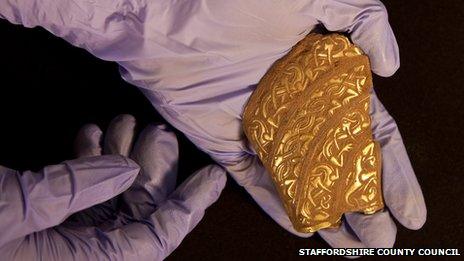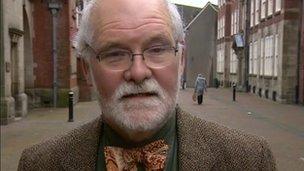Staffordshire Hoard: 'Opening a window into the Mercian kingdom'
- Published

The 81 new pieces of the Staffordshire Hoard will be valued by the Treasure Valuation Committee at the British Museum in March
Speculation has already begun about how much 81 newly-discovered pieces of the Staffordshire Hoard will be worth.
The pieces of Anglo-Saxon gold and silver were declared treasure by coroner Andrew Haigh on Friday and will now be valued by the British Museum.
There are two items in the current collection that do not sparkle as much as the others but which could be the most valuable to archaeologists researching the hoard.
"We found decorative copper alloy material about 100m from the place where the hoard was buried, which shows there's potential for other activity at the field," said county archaeologist Stephen Dean.
"The problem we had is that when we found the original hoard we never found a feature that it was buried in - a ditch or a pit - and we had no context to say exactly why the hoard was buried there.
"The copper alloy gives us evidence that there could've been other past activities beyond the one visit we know was made to bury the hoard."
He added: "It's fantastic for Staffordshire, it helps us inform our place in history and opens a window into the Mercian kingdom."
Anglo-Saxon shrine
Dr Kevin Leahy, from the Portable Antiquities Scheme, has catalogued all the new pieces.
He said the copper alloy fragments could be linked to a metal disc found with the original hoard by metal detectorist, Terry Herbert, in July 2009.
"It's very posh, similar in style to items found at the burial site at Sutton Hoo and tells us that the Anglo-Saxons potentially visited this place more than once", he said.
"[The site] may have been a shrine set around a large fine tree or something like that.
"We need to do more work here to try and find out why this magnificent deposit was placed where it was," he added.
Mr Dean said archaeology and metal detectorist teams had carried out a number of surveys on the field in Hammerwich and they would see what funding was available to do more work there.
The 81 pieces, which include a helmet check piece and cross-shaped mount, will be valued by the Treasure Valuation Committee at the British Museum at the end of March.
'Save the finds'
Stoke-on-Trent City Council, which is joint owner of the original hoard with the Birmingham Museum and Art Gallery, has said it will start a fundraising campaign to buy the new pieces.

Dr Kevin Leahy has catalogued the 81 new items
They acquired the hoard after raising £3.3m in 12-weeks through public and company donations and funding from five other local councils.
Councillor Mark Meredith said: "It would be wrong to speculate or pre-judge the Treasure Valuation Committee hearing.
"But we, together with our partners at Birmingham, are committed to doing everything we can to save these new finds so that they can be kept together with the original artefacts and can stay in the West Midlands region, where they belong."
The proceeds of any sale will be divided between Terry Herbert and Hammerwich landowner and farmer, Fred Johnson, as happened with the original hoard.
- Published4 January 2013
- Published25 December 2012
- Published18 December 2012
- Published18 December 2012
- Published18 December 2012
- Published21 July 2012
- Published3 July 2011